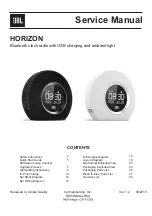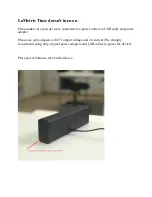
INSTRUCTION MANUAL
Radio-Controlled Clock
With this Radio-‐Controlled Clock is an extremely accurate timepiece. It can3 receive the time
signal transmitted by the National
Institute of Standards and Technology (NIST), which is regulated by 3 atomic
clocks and deviates less than 1 second within 3,000
years.
The NIST broadcasts the time signal (WWVB, 60kHz) continuously from Fort Collins, Colorado. This signal can be
received
anywhere in the continental USA and Canada that long wave (AM) radio reception is possible with a portable
radio. It is expected
that the signal can reach a distance of over 2,000 miles from the transmitter. Therefore, your
clock will receive the signal within the
broadcast range anywhere an AM signal can be received; generally
the signal cannot be picked up in massive metal and concrete
structures unless near a window. In addition,
some environmental effects (see below) may affect the transmitting distance and
reception.
For more information, please refer to the WWVB WEB page of NIST at:
http://www.boulder.nist.gov/timefreq/
Environmental Reception Effects
The Radio-‐Controlled Clock obtains the accurate time with wireless technology. Just as with all wireless devices,
the receiving ability
may be affected by, but not limited to the following conditions:
• Long transmitting distance.
• Nearby mountains and valleys.
• Among tall buildings.
• Near railways, high voltage cables, etc.
• Near freeways, airports, etc.
• Near construction sites.
• Inside concrete buildings.
• Near electrical appliances.
• Bad weather.
• Inside moving vehicles.
• Nearby metal structures.
P.1
SET / WAVE
RESET
Location Precautions
This clock receives a radio wave much like a TV
or radio. Be sure to locate it near a window or
some other location where reception is good.
Avoid the following locations, which can
interfere with proper reception:
Inside moving vehicles (automobile, train, airplanes
etc) which radio transmission or electronics will
interfere the reception of radio-‐controlled clock.
Next or close to power station.
Inside or near concrete/ steel bulidings
or structures, unless the clock is close/
next to a window (with curtain open).
Close to or on top of metal surfaces / plates.
Near construction sites, traffic
lights, roadside, neon lights
etc.
Too close to household appliances
(Computer, TV, video/audios, fax
machines, speakers).
Features
• Receive 60kHz WWVB signal transmitted by NIST at Fort Collins, Colorado, USA
• Automatic time and date adjustment after radio signal reception
• Calendar with day of the week display
• Hour, minute and second display
• Indoor temperature and remote temperature
• Centigrade or Fahrenheit temperature format
• Indoor temperature measurement range from -20
°
C ~ 70
°
C (-4
°
F ~ 158
°
F)
• Outdoor temperature measurement range from -50
°
C ~ 70
°
C (-58
°
F ~ 158
°
F)
• Temperature resolution 0.1
°
C (0.2
°
F)
• Clock operation temperature from 0
°
C ~ 50
°
C (32
°
F ~ 122
°
F)
• Time accuracy (Atomic clock): better than 1 second in 2 million years
• Time accuracy (free run): /-60 seconds per month
Location Precautions
This clock receives a radio wave much like a TV or radio. Be sure to locate it near a window or
locations where reception is good.
Avoid the following locations, which can interfere with proper reception:
Inside o r near concrete/ steel buildings
or structures, unless the clock is close/
next to a window (with curtain open).
Too close to household electronics
(Computer, TV, video/audios, fax
machines, speakers).
Next or close to a power
station.
Near construction sites, traffic lights,
roadside, neon lights etc.
Inside moving vehicles (automobiles, trains,
airplanes etc.) which radio transmission or
electronics will interfere the reception of radio-
controlled clock.
Close to or on top of metal surfaces / plates.
Before You Begin
To ensure proper functioning of the unit, please follow this set up procedure:
• Insert batteries for the main unit (Refer to section of Battery Installation)
• Place the main unit as close as possible next to the remote unit and insert batteries for the
remote unit.
• Position the remote unit and main unit within effective transmission range, which in usual
circumstances is 30 to 45 meters.
Note that the effective range is affected by the building materials, and where the main and
remote unit are positioned, try various setup for the best results.
A l’intérieur ou proche des bâtiments ou structures
en béton/acier, à moins que l’horloge soit proche
ou à côté d’une fenêtre (avec les rideaux ouverts)
A côté ou proche d’une centrale électrique
A l’intérieur des véhicules (automobiles, trains,
avions, etc.), dont la transmission radio ou
électronique interféra avec la réception.
Trop proche des appareils électroniques ménagers
(Ordinateur, TV, vidéo, fax, haut-parleurs).
Proche des sites de construction, feux
de circulation, bord de route, éclairage
au néon, etc.
Proche ou dessus des surfaces/plaques
métalliques
SET/WAVE
RESET
6
Battery Installation
• Open the battery compartment cover of the unit
• Insert 2 “AA” batteries in polarity (+) and (-) as indicated inside the battery compartment
• Close the battery compartment cover
Warning:
Do not mix old and new batteries. Do not mix alkaline, standard
(carbon-zinc) or rechargeable (nickel cadmium) batteries.
Do not touch any other button or setting on the unit. It will automatically receive the
remote temperature and time signal after batteries are inserted.
(See “Location Precautions” above).
Radio-Controlled Clock Reception
Your radio-controlled clock automatically receives the time signal everyday at midnight and
makes any required adjustments to the time setting. The WAVE OK indicator and the antenna
tower icon appear on the display when the time signal is successfully received or after manually
pressing the WAVE button.
Important:
Do not perform any button or switch operation while a signal reception operation
is in progress. You can activate a reception operation manually at any time by pressing the
WAVE button.
Note:
Frequent use of this feature may affect battery life.
Unsuccessful Signal Reception
If the automatic update is unsuccessful at midnight, the WAVE OK and the antenna tower icon
will disappear. The unit will attempt to receive the signal again every hour afterward for a
maximum of 4 hours.
After an unsuccessful signal reception, battery installation, or after reset, the unit will search for
10 minutes every 3 hours until the time signal reception is successful.
After successful reception of the time signal you may need to change the time zone or DST
setting. The default is Pacifi c Time zone and DST on. To change these defaults:
1. Press and hold the SET/WAVE button for DST for two seconds. The DST and time zone settings
will blink.
2. Press – key to set DST on or off.
3. Press + key to change the time zone until your desired time zone shows on the display.
P = Pacifi c Standard Time
M = Mountain Standard Time
C = Central Stardard Time
E = Eastern Standard Time
4. Press the set button to confi rm the time zone, DST set and go to calendar set. To exit the
setting mode press and release the set button until the display returns to normal time mode.
Manual Clock Setting
To Set the DST and TIME ZONE
1. Press and hold the SET/WAVE button for a couple of seconds and the unit will go to DST
and TIME ZONE set mode.
2. Press – key to toggle DST ON and DST OFF.
3. Press + key to change the time zone until your desired time zone is shown on the display.
3
Précaution d’emplacement
Cette horloge reçoit un signal radio tout comme une TV ou une radio.
Veuillez la placer près d’une fenêtre ou près des endroits ou la réception est bonne.
Evitez les emplacements suivants, qui peuvent interférer avec la bonne réception :
Caractéristiques
• Reçoit un signal 60kHz WWVB
• Ajustement automatique de l’heure après la réception du signal
• Calendrier avec affi chage du jour de la semaine
• Affi chage des heures, minutes et secondes
• Format 12 ou 24 heures
• Fréquence de l’oscillateur à cristal : 32.768kHz.
• Précision de l’heure (horloge radio-contrôlée) : mieux que 1 seconde en 3000 ans.
• Précision de l’heure (Exécution libre): +/-60 secondes par mois
• Fonctionnement de la température de 0°C à 50°C (32°F à 122°F)
• Gamme de mesure de température de 9.9°C à 50°C (14.2°F à 122°F)
• Résolution de la température 0.1°C (0.2°F)
Pour commencer
Décollez le plastique de protection sur l’écran LCD sur le dessus de l’horloge. Insérez les 2 piles
AA incluses. Aussi longtemps que les piles fournissent la puissance dans l’unité, l’horloge reçoit
le signal horaire et ajuste l’heure automatiquement. Aucun ajustement manuel n’est requis après
l’allumage. L’ajustement exact de l’horloge basé sur le signal horaire est supporté sur le
continent Américain et le Canada.
Nous vous recommandons de laisser l’horloge pendant la nuit pour chercher le signal horaire du
fait que la nuit permet une meilleure transmission du signal horaire.
























